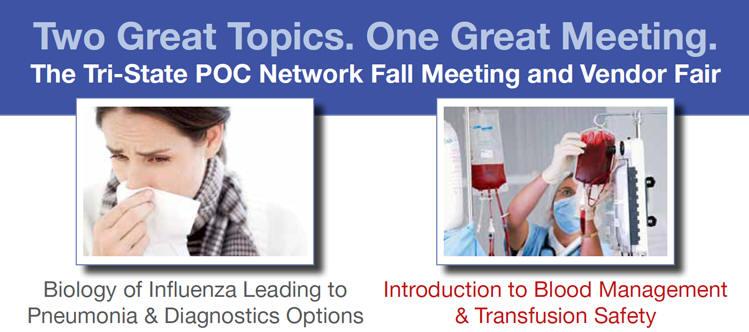|
October 3, 2012 Meeting Minutes
Welcome
Introduction to
Blood Management & Transfusion Safety
The Biology of
Influenza Leading to Pneumonia and Current Diagnostic
Options
Roundtables
The 2012 Fall meeting with Vendor
fair was held at the Doubletree Hotel in Alsip, Illinois on
Wednesday, October 3rd from 9:00 AM to 3:00 PM. The meeting
was attended by 34 registered healthcare professionals and
sponsored by Alere, Hemocue and MAS. Registered vendors
included: Abaxis, Alere, BD, Beckman Coulter, Enterix Inc,
Fisher HealthCare, HemoCue, Innovative Medical Systems,
ITC, Laboratory Data Systems, MAS, Nova Bio-Medical, PTS
Inc/CardioChek, Quidel, Radiometer, Roche CoaguChek, Roche
Glucose, Siemens, and Telcor.
Welcome: The meeting
commenced with opening remarks by Joanne McEldowney, RN.
Members of the core group include: Wendy Denk, Ingalls
Hospital, Harvey, IL; Joanne McEldowney, RN, Univ of
Illinois – Chicago, Chicago, IL; Gil Salas, Univ of Illinois
– Chicago, Chicago, IL and Sandra Curran, Univ of Illinois.
The
first session, “The Biology of
Influenza Leading to Pneumonia and Current Diagnostic
Options”, was presented by Norman Moore, PhD, Director
of Scientific Affairs, Infectious Diseases and was sponsored
by Alere. Dr. Moore gave a brief history of Streptococcus
pneumoniae and Influenza, emphasizing the significance of
both on the US population. Pneumonia is the sixth leading
cause of death in the US and the major cause of death from
infectious diseases. With an aging population, Pneumococcal
pneumonia cases may increase 96% between 2004 and 2040. As
for the Influenza virus, there are different strains each
year and 5-20% of the US population is affected annually.
The Infectious Disease Society of
American/American Thoracic Society Consensus Guidelines
include Diagnostic testing that requires a chest Xray or
other imaging techniques for a diagnosis of pneumonia and
recommends identifying the specific pathogens before
administering drugs.
Common Diagnostic tests for
Pneumonia: Gram stain, Sputum culture, Blood culture, Latex
agglutination assays, DFA/IFA, PCR, Serology, Urinary
antigen
Common Diagnostic tests for
Influenza: Viral culture, DFA, PCR and rapid tests.
The Vendor Fair was held from 10am
– Noon and once again we thank the vendors for their support
and the time they spent with us.
There are pros and cons for all
diagnostic tests, way too many to include in this synopsis.
There are, however, three ways to improve Influenza rapid
test performance: test early infections (at the “I think I’m
getting something” stage), ensure sample collection is
appropriate (NP swab and nasal wash), and limit the dilution
in transport media.
There is a connection between
influenza and pneumonia based on an Emerging Infectious
Disease study. Concurrent infection significantly increases
risk of complications and if only looking for influenza,
pneumococcal pneumonia may be missed or if only looking for
pneumonia, influenza may be missed.
Following
the Vendor Fair and lunch,
“Introduction to Blood Management & Transfusion Safety”
was presented by Joseph Thomas, RN, BSN/ Vice-President,
Program Services, Strategic Healthcare Group LLC and
sponsored by Hemocue. Although the opportunity for POC
testing could play a role in a blood management program,
bedside hemoglobin/coagulation testing is not performed at
all hospitals so the clinical laboratory provides hematology
and coagulation capabilities for the high acuity patient.
Joseph gave an informative talk about the need to address
the triggers for blood transfusions, transfusion ordering
practices and hospital anemia management and prevention.
Sandra
Curran led the Roundtable
Discussions
-
How are you authenticating
physician verbal POCT orders?
-
Do the Tight Glycemic
protocols using POC devices in critical care patients
improve outcomes or not?
-
Recent CAP or TJC outcomes
(fire drills, Physician Performing Microscopy, min/max
temperatures, verbal orders)
-
Causes and frequencies of
failed electronic transmissions of POC results. Upload
failures-why?
-
Anyone using gastric pH
testing for correct NG placement? Any problems
encountered because of erroneous test results? If
patient’s on an inhibitor, don’t need to measure the pH?
There will be no spring meeting;
the next meeting with a Vendor Fair will be October 2, 2013
at the Doubletree Hotel in Alsip.
Respectfully Submitted,
Wendy Denk, MT(ASCP) |

